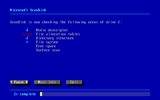
SCANDISK
Encyclopedia
.png)
MS-DOS
MS-DOS is an operating system for x86-based personal computers. It was the most commonly used member of the DOS family of operating systems, and was the main operating system for IBM PC compatible personal computers during the 1980s to the mid 1990s, until it was gradually superseded by operating...
and Microsoft Windows
Microsoft Windows
Microsoft Windows is a series of operating systems produced by Microsoft.Microsoft introduced an operating environment named Windows on November 20, 1985 as an add-on to MS-DOS in response to the growing interest in graphical user interfaces . Microsoft Windows came to dominate the world's personal...
systems which checks and repairs file system
File system
A file system is a means to organize data expected to be retained after a program terminates by providing procedures to store, retrieve and update data, as well as manage the available space on the device which contain it. A file system organizes data in an efficient manner and is tuned to the...
s and bad cluster
Cluster (file system)
In computer file systems, a cluster or allocation unit is the unit of disk space allocation for files and directories. To reduce the overhead of managing on-disk data structures, the filesystem does not allocate individual disk sectors, but contiguous groups of sectors, called clusters.On a disk...
s on the hard drive. It was introduced in MS-DOS version 6.2. Previous versions of MS-DOS supplied only the simpler, purely text-based program CHKDSK.
ScanDisk included a more user-friendly interface than MS-DOS CHKDSK, more command-line and other configuration options, and the ability to detect and sometimes recover from physical errors on the disk. Unlike CHKDSK, ScanDisk would also repair crosslinked files.
In Windows 95
Windows 95
Windows 95 is a consumer-oriented graphical user interface-based operating system. It was released on August 24, 1995 by Microsoft, and was a significant progression from the company's previous Windows products...
onwards, SCANDISK also had a graphical user interface
Graphical user interface
In computing, a graphical user interface is a type of user interface that allows users to interact with electronic devices with images rather than text commands. GUIs can be used in computers, hand-held devices such as MP3 players, portable media players or gaming devices, household appliances and...
, although the text interface
Text user interface
TUI short for: Text User Interface or Textual User Interface , is a retronym that was coined sometime after the invention of graphical user interfaces, to distinguish them from text-based user interfaces...
continued to be available for use in single-tasking ("DOS") mode.
However, SCANDISK cannot check NTFS
NTFS
NTFS is the standard file system of Windows NT, including its later versions Windows 2000, Windows XP, Windows Server 2003, Windows Server 2008, Windows Vista, and Windows 7....
disk drives, and therefore it is unavailable for computers that may be running NT based
Windows NT
Windows NT is a family of operating systems produced by Microsoft, the first version of which was released in July 1993. It was a powerful high-level-language-based, processor-independent, multiprocessing, multiuser operating system with features comparable to Unix. It was intended to complement...
(including Windows 2000
Windows 2000
Windows 2000 is a line of operating systems produced by Microsoft for use on personal computers, business desktops, laptops, and servers. Windows 2000 was released to manufacturing on 15 December 1999 and launched to retail on 17 February 2000. It is the successor to Windows NT 4.0, and is the...
, Windows XP
Windows XP
Windows XP is an operating system produced by Microsoft for use on personal computers, including home and business desktops, laptops and media centers. First released to computer manufacturers on August 24, 2001, it is the second most popular version of Windows, based on installed user base...
, etc.) versions of Windows; for the purpose, a newer CHKDSK is provided instead--this is not to be confused with the older MS-DOS CHKDSK.
On Unix-like
Unix-like
A Unix-like operating system is one that behaves in a manner similar to a Unix system, while not necessarily conforming to or being certified to any version of the Single UNIX Specification....
systems there are tools like "fsck_msdosfs" to do the same task.
External links
- Description of ScanDisk for Windows (Scandskw.exe) in Windows 98/Me – Microsoft TechNet article

